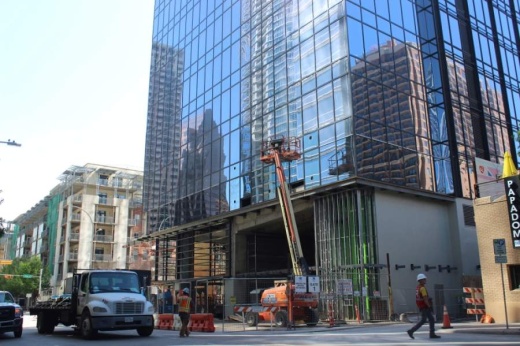Officials said Travis County has successfully dampened the rapid rise of new cases; however, they said a large majority of the new cases they are seeing are specific to one demographic: residents who still have to go to work.
Health care, construction and grocery store employees are making up a significant portion of new coronavirus cases in Travis County, said Dr. Mark Escott, Austin-Travis County interim health authority. Escott said he could not provide specific numbers, but a city spokesperson said Escott was referencing occupational data that Austin Public Health is collecting but will not release. Austin Public Health has released ZIP code and racial data on confirmed coronavirus cases and hospitalizations.
Although much of the Austin and Texas economies have been pinned down under stay-at-home orders since March, workers in the health care, construction and grocery store industries were all deemed essential to the operation of society and, thus, have been going to work each day while almost everyone else shelters in place. The industries have since become hotbeds for new coronavirus cases, officials said.
As testing capacity has ramped up—roughly 1,000 tests per day are being administered communitywide, which is still only half of what an influential Harvard study recommends—Escott said health officials are targeting construction sites and nursing homes, but the efforts have moved slowly. Austin Public Health has only completed testing of workers and residents at “one or two” of the area’s 15 nursing home and long-term care facilities, which officials have called "shockingly vulnerable" to the virus. As of May 5, these facilities have seen 335 cases and 30 deaths.
However, Escott said construction was the “dominant industry” when it came to workers with new coronavirus cases.
The city has passed extensive rules for mitigating the risk of transmission at construction sites, from social distancing to prohibiting retaliatory action against a worker who does not feel safe enough to come to work.
Ben Brenneman, business manager for the local electrical workers union, IBEW 520, said pressure has been placed on code enforcement to perform regular compliance checks at construction sites.
Texas Gov. Greg Abbott issued orders that vulnerable workers who do not feel safe going to work can qualify for unemployment. However, such protections do not extend to undocumented immigrants, who, according to the Workers Defense Project, make up about 50% of construction workers in Texas.
“We’re urging everyone to stay cautious,” District 4 City Council Member Greg Casar said. “Even still, there are often times when lower-income workers have to choose between social distancing and putting food on the table.”
Brenneman said he remains “absolutely concerned” about the vulnerability of construction workers to the coronavirus. He said construction receiving the “essential business” tag from Abbott was a “double-edged sword.”
“We understand we have an obligation to our customers. That’s part of providing manpower for contractors,” Brenneman said. “On the other hand, it’s a global pandemic, and it’s a situation that bears serious action, but we don’t have a whole lot of control over it. We’re continuing to man the job as we need to.”
Eric Tang, a faculty fellow with The University of Texas Institute for Urban Policy Research and Analysis, said low-income workers and those on construction sites are aware of the risks and aware of the benefit of staying home and social distancing but are disciplined to the idea that if they do not go to work, they will not have a job, and there is no guarantee they will be rehired nor any guarantee of qualifying for unemployment.
Tang said as restaurants reopen, which employ many workers from the same demographics as construction workers, the city needs to figure out how to save workers from making the false choice between staying home to protect themselves and the community or economic security.
“How are we addressing that calculation they’re making in their head where they know the risks but there is no protection for them economically should they not go to work?” Tang said. He further urged City Council on May 5 to consider how federal funding could be used to offer a safety net to such workers.
That afternoon, Abbott followed up his decision to open restaurants, malls and movie theaters May 1 with an order allowing hair salons, barber shops and gyms to reopen May 8.
District 6 Council Member Jimmy Flannigan said reopening businesses poses several risks but mostly to the employees who have to work at the businesses.
“The struggles of reopening businesses are not about whether or not someone patronizing that business is at risk; it’s really about the fact that you need employees in the business, and those are the ones at risk,” Flannigan said. “The protesters holding up signs that say ‘I need a haircut’ ... It’s not about whether or not you get sick from getting a haircut. It’s about your barber or the folks working in the salon that get infected. That really does fall on business owners as they make their decision about how they’re going to survive and [on] the programs we create to ensure they do survive.”





